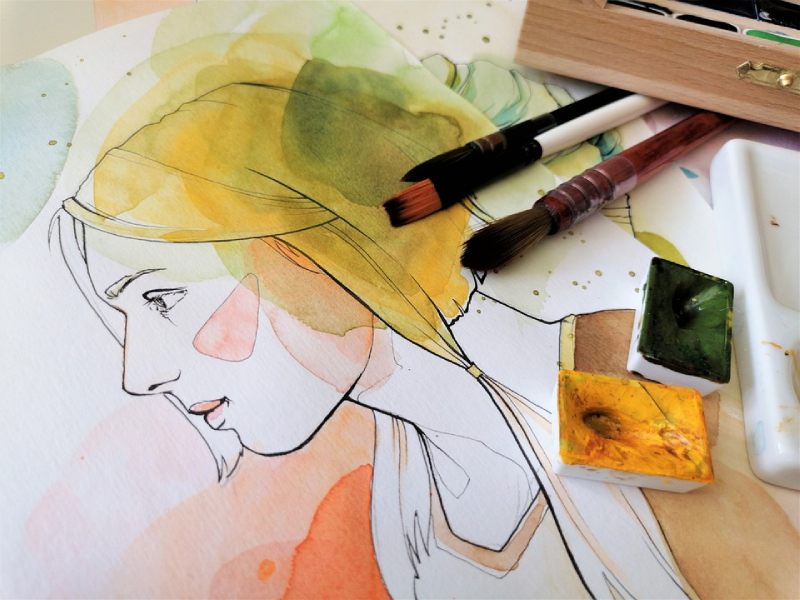Watercolor paint is made up of a colored pigment in a water-based binder. That means when mixed with water, watercolor paints turn translucent and soluble.
Due to this water solubility, some people find watercolors hard to control.
Here are five tips on how to make elegant watercolor paintings, without the struggle.
Table of Contents
Toggle1. Choose the Right Paper
Of course, paper is essential for watercolor paintings. But what kind of watercolor paper? How does paper affect your painting?
Watercolor paper is thicker than normal because it needs to be able to absorb the amount of water laid down. It is made to absorb the water and keep the pigment at the surface.
Regular printer paper is made to keep all the liquid mass at the surface of the paper.
If you use printer paper not only will your paper pill because of how weak the paper is but once the paper absorbs as much water as it can, your painting will be ruined by the buckling. Buckling is what happens when your paper has held too much water and cannot shrink back to its original size.
Watercolor paper expands when wet and shrinks back when dry, leaving you with a flat painting.
The texture of your painting is determined by the press of your paper. Cold-press paper has more grain or tooth. Hot-press paper has a smoother surface.
This article can help you choose the best watercolor paper for your next project.
2. Work Light to Dark
When working with watercolor it is important to remember their transparency. Work light to dark, adding layer by layer.
It is also important to allow each layer to dry before applying the next.
To pull this off, paint the background first, then the middle ground. Lastly, add the finishing touches in the foreground.
3. Use Quality Paints
There are two types of watercolor paints; cakes and tubes. Both are great and which you use is really just a matter of preference.
Whichever type you prefer, be sure to purchase high-quality paint. The quality of the paint determines the quality of your painting. Low-quality watercolor paint is chalky and crackles as it dries.
There are two main levels of quality in watercolor paint; artist’s quality and student quality. You might consider the student’s quality best for a beginner.
While this is true to some extent, student’s quality watercolor paints are simply lower quality paints.
You can save a few dollars in the long run by using student’s quality but you won’t learn how to paint like a professional unless you use professional quality tools.
Also Read: Major points of difference between Functional and Non-Functional testing
4. Workspace
It is very important to keep your workspace clean and organized. Having less clutter in your workspace causes less stress and distraction. This allows creativity to flow and brings the focus to your piece.
There are several different tools that can help you keep your workspace clean.
Paper towels are an essential tool to have when painting with watercolor. You can dry your brushes on the paper towel after cleaning.
When painting skies, you can crumple up the towel and dab the wet paint off creating fluffy clouds.
If you have too much paint on your brush just lightly touch the towel with the tip of your brush.
If you made a mistake on your painting, wet only the paint you want to pick up and press the paper towel on the spot. There are so many uses for paper towels when creating a watercolor masterpiece.
An extra vessel of water is another great tool. When washing off your brushes, remove most of the color in the first vessel, and clean the last bits in the second.
That way you have a 100% clean brush to use with no pigment residue in your water.
It’s always helpful to have a system for your paints, brushes, and other tools. This way you can easily access them in the middle of working without causing too much of a stir.
5. Choose Brushes Accordingly
There are six main terms that are used to classify watercolor brushes.
Capacity is the amount of water a brush can hold. Point is how well a brush holds its pointed tip when wet. Good brushes will have decent capacity and hold their point well.
Snap and spring refer to the brushes’ ability to hold their shape and snap back to their original shape after being pushed onto the page.
A brush either has a good flow or dumps onto the page. Flow is the rate at which the paint is released onto the paper. If a brush dumps, that means that it releases all the paint at once, which is never a good thing.
Conclusion
Anytime you are learning a new skill, the key to improvement is practice. Keep painting as much as you can, and your art will improve.
Paint without boundaries, judgment, and time limits, and use these five tips.
Every professional artist started as a beginner just like you. If your painting does not turn out the way you expected, you learned something. So, grab those watercolors and start painting
Shashi Teja
Related posts
Hot Topics
What is Kafka Used For: A Complete Guide
What is Kafka used for? If you’ve been diving into the world of distributed systems, microservices, or data streaming, you’ve…
How Do Password Managers Work? The Guide That Finally Makes Sense
Ever wonder how do password managers work and whether they’re actually safe? I get it. The idea of putting all…



